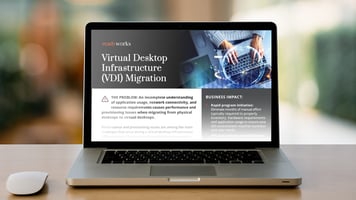Companies may have hoped for a wholesale return to the office when pandemic restrictions were lifted, but almost 3 years from the start of lockdowns, flexible working, it seems, is here to stay. Those mandating office working have seen pushback, in some cases with staff quitting jobs.
"The Great Resignation" is having a lasting impact, and many business leaders are now focused on talent retention. Forrester advises them to shift their idea of the office, thinking of it as “a network of locations, practices, technologies and people that empowers employees to be successful and productive while honoring their individual needs”. Gartner talks of delivering the ”digital workplace” to enable more effective ways of working and raise employee engagement and agility.
If you’re deploying technology to support the digital workplace, you may be investigating virtual desktop infrastructure (VDI) to allow users to work remotely over myriad endpoint devices.
VDI advantages
- Security: Applications are accessed remotely, so if a user’s device is stolen company data remains secure. IT can prevent users from incorporating unauthorized software into the desktop and application virtualization provides greater security. Highly regulated industries are supported as data is held on a central server preventing users from saving it elsewhere.
- Cost: With most of the processing power held at the server, hardware cost savings are made possible.
- Simplified management: IT administrators can manage OS updates and patches and deliver policies centrally, reducing complexity compared to the management of laptops running local operating systems.
- Consistent user experience: Easily integrate BYOD policies, allowing users to access a standardized desktop from a personal device without needing to load applications on that device.
VDI Deployment options
With several deployment options available, which works for you?
- VDI: Virtual desktops are created, managed, and run by hypervisors on virtual machines (VMs) over a centralized server, with multiple instances hosted on the same server. Each virtual desktop contains an OS image, such as Microsoft Windows. Users must connect to the server to access the virtual desktop on their device, with a software layer or ‘connection broker’ assigning a virtual desktop from the pool.
- Desktop-as-a-Service (DaaS): Virtual desktops are hosted in the cloud with the cloud provider managing infrastructure and administration functionality.
- Remote Desktop Services (RDS): Remote user access to desktops and applications is provided over a Server OS supporting multiple users simultaneously.
While RDS can be a more cost-effective solution because it uses the Server OS rather than Windows, there may be application compatibility issues, so in organizations with complex workloads and work patterns, VDI or DaaS may be more suitable.
VDI requires additional set-up, hardware costs and in-house maintenance to maintain security and end user availability compared to DaaS, but this means greater in-house control, and often better performance. Users must have internet access to connect to the virtual desktop over DaaS, but connection to a VDI platform can be made over the corporate network. While a typical pay-per-user agreement with a service provider may appear to offer a more affordable option, for fast-growing companies and those with large numbers of users it may be more cost-effective to leverage an in-house VDI platform and benefit from resource scaling.
Learn how ReadyWorks and accelerate
your VDI migration.
DOWNLOAD NOWVDI Implementation Best practices
Think VDI is the right solution for your organization? Follow these best practices:
Assess requirements: Understand the applications users’ access (and categorize by role, business, etc.), users’ additional hardware requirements and the usage figures for each application to plan your VDI deployment. Knowing your end users will help you decide on persistent vs non-persistent VDI deployments. Persistent VDI ensures a user always accesses the same virtual desktop with all applications and changes retained at log off. Nonpersistent VDI means users are assigned random VMs and changes are not saved, making them more suitable for shift workers in call centers or warehouses, etc.
Additionally, talk to or survey business teams and end user to understand specific hardware and other needs ahead of deployment.
Tip: If you’re supporting multiple versions of the same application, now is a good time to manage an application rationalization exercise, to understand needs going forward.
- Define and communicate policies: Decide on the types of devices you support (as part of your BYOD strategy) and communicate this to users alongside policies defining what they can and should do, such as deploying and updating antivirus software, etc.
- Ensure resource availability: Monitor usage to ensure you have the resources to support all end user needs without service disruption. Leverage digital experience tools (DEX) to identify issues and correct them before users are impacted.
- Maintain security: By treating end user devices as ‘thin clients’ you can prevent users from installing software or reconfiguring an app setting permanently. Implement security monitoring of connections to your VDI platform from external devices to ensure access is given only to legitimate users following procedures, and to expose vulnerabilities.
VDI Challenges
To manage a successful VDI deployment and security and accessibility, IT faces several challenges:
- Planning: Your IT environment is becoming more complex, with data held across many IT management – or hybrid digital infrastructure management (HDIM) – tools, as well as other data stores outside of IT. To gain information on application and device usage, along with user type and location, traditionally requires manual input. Manual data aggregation and analysis takes time and can create errors and program risk. End user communications and surveys require additional time and effort.
- Rollout: Setting up and rolling out VDI capabilities will depend on the user needs. If customization is needed, it could require a comprehensive communications program, to explain the program and the part users need to play, scheduling them and directing them to where they can get more help. You’ll also need to interact with many HDIM tools to manage the rollout, with manual activity adding further chances for issues in rollout and business disruption.
- Management: Leverage capabilities such as DEX and cybersecurity asset management tools to understand ongoing usage and highlight any vulnerabilities but troubleshooting and addressing issues will require information held elsewhere, such as user location, device and more. Aggregating this data to make decisions adds time and complexity.
Using digital workplace orchestration
A VDI deployment will be just one of the capabilities you implement to support the digital workplace. As you evolve, your IT environment becomes more complex, making it harder to manage using manual processes.
You can cut manual effort and automate and orchestrate your disparate HDIM tools using a digital platform conductor, a tool recognized in 4 Gartner hype cycles. A DPC connects to all your tools, as well as sources of data outside IT, allowing you to:
- Automate data aggregation, normalization, and analysis, reducing the risk and time to understand user requirements and usage patterns for better planning and decision-making.
- Augment your IT data with specific user requirements leveraging automated end user communication and surveys, with responses automatically incorporated into your central view.
- Orchestrate your HDIM tools to benefit from end-to-end automation, including scheduling, end user communications, rollout, and reporting, leveraging pre-defined events, dates, and parameters to trigger automated workflows when the estate is ready, and risk are removed.
- Automatically integrate data from monitoring tools with your real-time estate data to better understand issues and automate remediation workflows before issues occur or users are impacted.
Book a demo with ReadyWorks to understand how you can benefit from digital workplace orchestration using a DPC to cut the time, risk, and effort of your VDI deployment.

